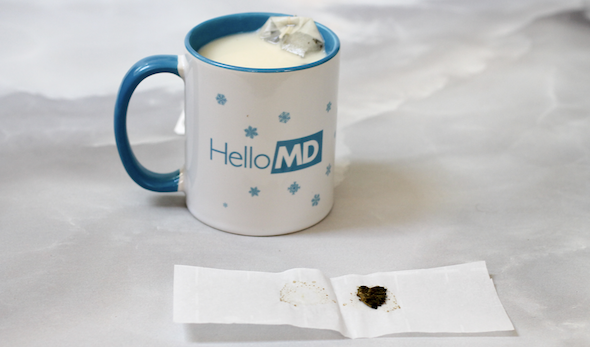Edibles are a fantastic way to consume cannabis, but they take a little work. If you’re anything like me, there may be days when you want an edible, but don’t want the hassle of cooking and baking. You may live in a place where you can legally buy premade marijuana edibles. But sometimes you don’t have any on hand, and a trip to the dispensary or a home delivery just isn’t going to work.
So, what are you to do if all you’ve got is cannabis flower, and you want a quick way to turn it into an edible? Try out my secret recipe for rosin tea.
FOLLOW US ON FACEBOOK & INSTAGRAM
You may have heard of rosin as a quick and easy way to make cannabis extracts at home. But few people realize that you can use this same technique to put together a tasty cup of cannabis tea in no time.
In less than five minutes, you can turn a little bit of cannabis flower into a cup of hot, cannabis- infused tea. This tea is potent and completely customizable with your favorite flavors. And since you’re making it from flower, it will also be strain-specific.
What Is Cannabis Rosin?
Before we get to the tea recipe, you may want to learn a little bit more about cannabis rosin.
Rosin is a type of cannabis extract or concentrate that’s distinguished by the way it’s made. To create rosin, you use pressure and heat to literally squeeze the cannabinoids and terpenes out of the plant.
On a commercial scale, rosin producers use hydraulic presses that can exert huge amounts of pressure and make big batches of rosin. But you can also make rosin at home using a simple flat iron hair straightener.
RELATED: WHAT IS CANNABIS ROSIN & HOW DO YOU USE IT?
Why Some Folks Prefer Cannabis Rosin
While rosin isn’t the most common way to make cannabis concentrates (mostly due to higher costs for production), it does boast a few benefits that are hard to find in other kinds of concentrates.
Here are a few of the main reasons that some people prefer rosin:
1. You Don’t Need Solvents to Make Cannabis Rosin
Some people prefer rosin, because it’s a method of extraction that doesn’t use solvents. This is a big departure from the usual ways of creating concentrates.
Chemical solvents are often times part of the process of making cannabis extracts. The most common solvents used include:
- Butane
- Naphtha
- Propane
- Hexane
- CO2
- Alcohol
The solvents pull the active cannabinoids and terpenes out of the plant, and then the solvents evaporate, leaving behind just the extract. But unfortunately, these processes aren’t perfect, and they sometimes leave behind trace amounts of solvents.
Since many of these solvents have known negative health implications, some folks prefer not to consume cannabis concentrates that use solvents to minimize the risk of exposure to potentially harmful chemicals.
Rosin, which only uses heat and pressure, can be a very attractive alternative for those looking to go for solventless cannabis extracts.
RELATED: UNDERSTANDING CANNABIS CONCENTRATES & HOW TO USE THEM
2. Marijuana Rosin Gives You the Full Spectrum of Cannabinoids & Terpenes
Another reason some people prefer rosin is that it offers a full-spectrum blend of cannabinoids and terpenes. Different methods of making concentrates can result in different blends of cannabinoids and terpenes. Some methods can actually destroy many of the medicinally effective compounds available in the plant, while preserving tetrahydrocannabinol (THC), the most common cannabinoid.
While some prefer the effects of isolated THC, many find its psychoactive property overwhelming, and prefer to get the full spectrum of cannabinoids and terpenes that a particular strain has to offer. These full-spectrum concentrates, like rosin, preserve the original blend of chemicals and allow the true character of the marijuana strain to shine through.
3. Cannabis Rosin Is More Flavorful Than Other Concentrates
Because rosin preserves the full spectrum of chemicals, including flavor- and aroma-creating terpenes, it’s also a particularly flavorful and aromatic concentrate.
Rosin contains natural terpenes from the cannabis strain, so will often smell similarly to the original flower. When it comes to including rosin in edibles, this means that you should pick cannabis strains with flavors that blend well with the flavors in your food. For rosin tea, I find that floral or fruity marijuana strains tend to work best.
Ingredients for Tea Infused With Cannabis Rosin:
- Cannabis flower
- Tea bag of your choice
- Cream
- Water
Equipment
- Flat iron hair straightener
- Parchment paper
- Oven mitt or heavy-duty cloth
How to Make Cannabis Rosin
In order to make rosin tea, you first need to learn how to make rosin. Don’t worry. This is a very simple process.
- Place your flat iron hair straightener on a hard, clean and heat-resistant surface. Then turn it on to preheat. If your flat iron is adjustable, I recommend setting it to 300 degrees F. If your iron doesn’t have specific temperature settings, put it on the lowest setting possible. In general, rosin can be made at temperatures between 280–330 degrees F.
- Take a small bud of cannabis (around the size of a shelled peanut) and place it on a piece of parchment paper that’s about 2 by 4 inches. Fold the parchment over to cover the bud. Some people like to fold the edges of parchment as well, so that the bud can’t fall out and is encased in a little pouch.
- When your flat iron is fully heated, rest it against a hard, clean, heat-resistant surface and open the blades. Carefully place your folded parchment between the blades of the flat iron. Make sure that the bud is in position to be squeezed between these blades once you press down.
- Then, using an oven mitt or heavy cloth over your hand to protect it from heat, press the blades together and down against the hard surface. Press down as hard as you can for 10–15 seconds.
- Release the pressure, and carefully pull out the parchment paper. When you open the paper, you’ll see a flattened bud and some cannabis rosin stuck to the paper.
Many people focus on what’s left behind on the paper, and you can consume that later on. But the flattened cannabis bud will also be full of rich rosin, which will defuse nicely into your tea.
Using these “tea buds” in your tea, rather than just putting the concentrate directly into your mug, means you won’t find a hunk of rosin stuck to the side of your mug if your water isn’t hot enough. The tea buds also stick together nicely so that you don’t have to worry about cannabis flower breaking apart and floating around in your tea cup.
That said, set the parchment aside and take the flattened bud out to make the tea. You can use it right away or save it for later. I like to make a bunch of these little tea buds at once so they’re ready to go when I feel like making rosin tea.

How to Make Tea Infused With Cannabis Rosin
- Once you have your tea bud, you’re ready to make the tea. This is the easy part. To start, put the bud directly into your tea cup.
- Pick out some tea to blend with your rosin. You can use any tea you’d like, but I recommend thinking about the flavors that will work well with your flower. For example:
- Is the marijuana you used a lemony sativa strain? If so, try a lemon-flavored black tea.
- Is your cannabis more of a floral-smelling strain? If so, try mixing the rosin you made with lavender tea.
- Are you going to use a cannabis strain that has fruity notes? Go with a tropical hibiscus tea that may include fruit like mango or coconut.
Once you’ve chosen your tea, add the tea bag to your cup.
- Add some boiling water to the cup and let your tea steep for 2–3 minutes. Then pour in some cream. The cream is essential, because it binds with the cannabinoids in your rosin tea so that your body can better absorb them. Make sure not to skip this step or the tea will be much less effective.
RELATED: WHY YOU NEED TO EAT FAT WITH YOUR CANNABIS
And that’s all it takes. In just a few minutes, you can make a single serving of strain-specific rosin tea. Let the tea cool down to your preferred temperature and enjoy.
Photo credits: Pixel-Shot/Shutterstock.com (main image), Emily Earlenbaugh (body image)
If you’re new to cannabis and want to learn more, take a look at our Cannabis 101 index of articles. And if you have questions about cannabis, ask them and our community will answer.






